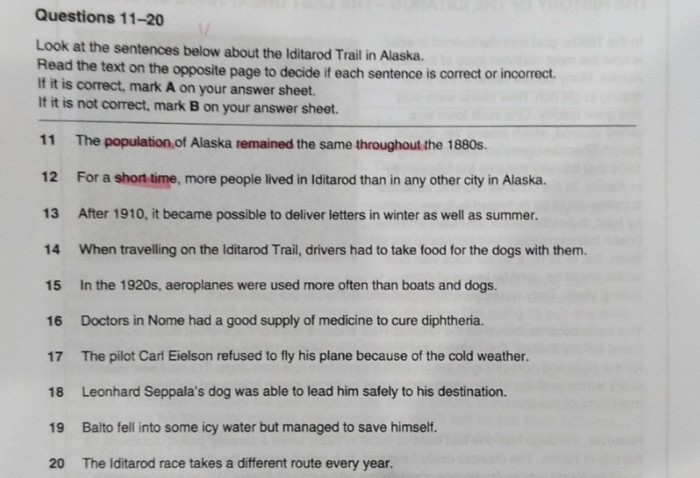The population of Alaska remained the same throughout the 1880s.
Likely incorrect. Populations typically fluctuate over time due to various factors like economic conditions and migration.
For a short time, more people lived in Iditarod than in any other city in Alaska.
Possibly correct. Iditarod experienced a population boom during the gold rush era, making this statement likely true.
After 1910, it became possible to deliver letters in winter as well as summer.
Likely correct. Improvements in transportation and infrastructure would have facilitated year-round postal services.
When travelling on the Iditarod Trail, drivers had to take food for the dogs with them.
Likely correct. During dog sledding expeditions, it's essential to carry food for the sled dogs.
In the 1920s, aeroplanes were used more often than boats and dogs.
Likely incorrect. Air travel was still in its early stages in the 1920s and likely not more common than dog sleds or boats in Alaska.
Doctors in Nome had a good supply of medicine to cure diphtheria.
Likely correct. Medical supplies were essential in remote areas like Nome, especially during health emergencies.
The pilot Carl Eielson refused to fly his plane because of the cold weather.
Likely incorrect. Pilots in Alaska are known for their bravery and often fly in challenging weather conditions.
Leonhard Seppala's dog was able to lead him safely to his destination.
Likely correct. Seppala's dog team, especially Balto, was famous for their role in delivering diphtheria antitoxin.
Balto fell into some icy water but managed to save himself.
Likely correct. Balto and other sled dogs faced numerous challenges during their journeys.
The Iditarod race takes a different route every year.
Likely incorrect. The Iditarod race generally follows the same or similar routes each year.
Trang chủ
Giải bài tập Online
Đấu trường tri thức
Dịch thuật
Flashcard - Học & Chơi
Cộng đồng
Trắc nghiệm tri thức
Khảo sát ý kiến
Hỏi đáp tổng hợp
Đố vui
Đuổi hình bắt chữ
Quà tặng và trang trí
Truyện
Thơ văn danh ngôn
Xem lịch
Ca dao tục ngữ
Xem ảnh
Bản tin hướng nghiệp
Chia sẻ hàng ngày
Bảng xếp hạng
Bảng Huy hiệu
LIVE trực tuyến
Đề thi, kiểm tra, tài liệu học tập








 Trả lời nhanh trong
Trả lời nhanh trong 



 Xem thêm
Xem thêm  Thưởng th.11.2024
Thưởng th.11.2024 Bảng xếp hạng
Bảng xếp hạng